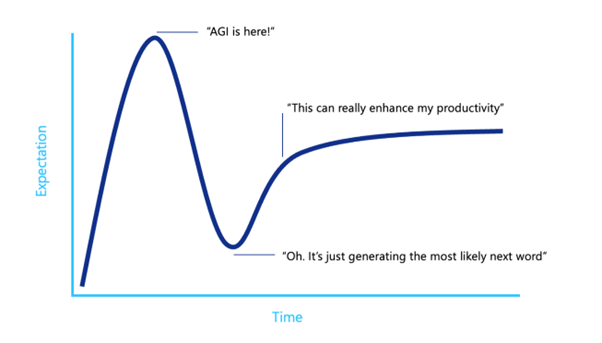The landscape of Analytics and Business Intelligence (BI) is undergoing a significant transformation thanks to the emergence of Generative AI and Large Language Models (LLMs) in particular. After the initial peak of excitement, anxiety and anticipation, we are now entering the productive phase of the hype-cycle for LLMs.
The potential of LLMs to revolutionise data analysis, predictive modelling, and business decision-making are beginning to be realised in practical, impactful ways. From automating complex data interpretations to facilitating user-friendly data access through natural language queries, LLMs are enhancing efficiency and making sophisticated analytics more accessible.
In this article, we will explore how LLMs are reshaping the field of Analytics and Business Intelligence, delving into their applications, benefits, and the future trajectory of this transformative technology.

Fig. 1 - A depiction of the famous Gartner hype-cycle chart with reference to LLMs
The journey so far
The famous Gartner "hype cycle" charts the level of expectation of a brand-new technology over time. The trend shows an initial peak, followed by a sharp decline, followed by a long-term plateau as the technology becomes widely understood and its applications arise.
Time and again this chart has been applied to new innovations and it arguably applies well to the journey so far with Large Language Models. Many of us were shocked by what it could achieve in the early days. The responses from ChatGPT appeared so intelligent that it was natural to assume AGI (Artificial General Intelligence) was just around the corner (it may still be!).

However, it then dawned on us that the thing that these models does incredibly well is predicting and choosing which word to say next. The remarkable thing is that by doing this, the model can show such a surprising resemblance of true intelligence. This realisation, along with difficulty understanding simple mathematics and hallucinating facts somewhat burst the bubble of the initial hype.
Yet, we are now realising that this property of LLMs - to be very good at generating feasible language - has some profound utility and application, particularly in the realms of translation (including translating spoken word into code) and creative endeavours. This is true not just for LLMs but other Generative AI, such as text-to-image models. We are now understanding the use cases that GenAI is good for, and those for which it is not. This can be seen across the world of technology, where LLMs are being integrated into certain applications, but held back in places where hallucinations can be damaging.
Next we take a look at where LLMs and GenAI are being integrated into the modern data stack.
Enhancing the modern data stack
Whilst there is no one-size-fits-all modern data stack, we can typically summarise it as shown in the diagram below. Of course there are multiple possible variations of this, with tools that sit between these elements and some that span multiple elements.

Fig. 2 - A simplified view of a generic modern data stack
For this topic we have focussed on the verbs involved in the modern data stack, rather than specific tools or platforms.
Here are some of the ways LLMs are enhancing processes across this stack, with each labelled in its corresponding part of the diagram above:
1. Data cleaning and pre-processing
Assist in identifying and rectifying data inconsistencies, missing values, and errors through natural language instructions.
Identify personally identifiable information (PII) within datasets without having to manually check.
2. Workflow automation & Code Migration
Automate routine data analysis and reporting tasks, freeing up human resources for more complex analytical work.
Develop chatbots and virtual assistants that can handle data queries, provide analytics insights, and assist in decision-making processes for your specific domain.
Convert legacy code from outdated systems to modern programming languages and frameworks using K.Convert
3. Forecasting and Anomaly Detection
Use historical data to make predictions about future trends and events, enhancing the accuracy of demand forecasting, financial forecasting, and other predictive tasks.
Identify outliers or unusual patterns in data that may indicate fraud, errors, or significant events.

4. Sentiment Analysis and Segmentation
Analyse customer feedback, reviews, and social media posts to gauge customer sentiment and improve products or services.
Identify and segment customers based on behaviour, preferences, and demographics to tailor marketing and sales strategies.
5. Metadata generation and documentation
Automatically generate metadata descriptions for datasets, improving data cataloguing and search-ability.
6. Natural Language Queries
Enable users to query databases using natural language, making data access more intuitive and reducing the need for specialised query languages like SQL.
7. Auto-insights & Summaries
LLMs can automatically generate insights from data by identifying trends, patterns, and anomalies, thereby helping in quick decision-making.
Summarise large datasets or reports into concise, understandable summaries, which is especially useful for executive briefings and reports.

8. Dashboard creation
Automatically generate and update BI dashboards with relevant data visualisations and insights based on user preferences and natural language inputs.
Create interactive and conversational BI reports where users can ask questions and get insights in real-time.
Conclusion
Large Language Models are being applied in all areas of a modern data stack, and there are likely even more examples beyond those discussed here. In our upcoming blogs, we'll begin to dig into some of these use cases in more detail.
In the meantime, if you have any questions or require a trusted advisor on your journey with Gen AI enhanced analytics, regardless of what tools and technologies you use, please get in touch with us.
Our address: sales.sea@keyrus.com
